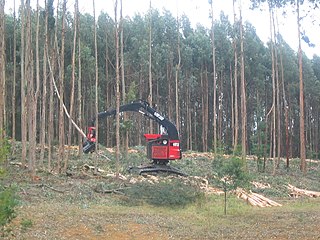
Pulp is a fibrous lignocellulosic material prepared by chemically, semi-chemically or mechanically producing cellulosic fibers from wood, fiber crops, waste paper, or rags. Mixed with water and other chemicals or plant-based additives, pulp is the major raw material used in papermaking and the industrial production of other paper products.

Paper engineering is a branch of engineering that deals with the usage of physical science and life sciences in conjunction with mathematics as applied to the converting of raw materials into useful paper products and co-products. The field applies various principles in process engineering and unit operations to the manufacture of paper, chemicals, energy and related materials. The following timeline shows some of the key steps in the development of the science of chemical and bioprocess engineering:

UPM-Kymmene Oyj is a Finnish forest industry company. UPM-Kymmene was formed by the merger of Kymmene Corporation with Repola Oy and its subsidiary United Paper Mills Ltd in 1996. UPM consists of six business areas: UPM Fibres, UPM Energy, UPM Raflatac, UPM Specialty Papers, UPM Communication Papers and UPM Plywood. The Group employs around 17,000 people and it has production plants in 11 countries. UPM shares are listed on the NASDAQ OMX Helsinki stock exchange. UPM is the only paper company which is listed in the global Dow Jones Sustainability Index and also a member of the United Nations Global Compact organization.
Portable sawmills are sawmills small enough to be moved easily and set up in the field. They have existed for over 100 years but grew in popularity in the United States starting in the 1970s, when the 1973 oil crisis and the back-to-the-land movement had led to renewed interest in small woodlots and in self-sufficiency. Their popularity has grown exponentially since 1982, when the portable bandsaw mill was first commercialized.

The pulp and paper industry comprises companies that use wood, specifically pulpwood, as raw material and produce pulp, paper, paperboard, and other cellulose-based products.

Svenska Cellulosa Aktiebolaget SCA is a Swedish timber, pulp and paper manufacturer with headquarters in Sundsvall. It has approximately 3,300 employees and a turnover of approximately SEK 20.8 billion. Its main products include many one-use paper products, containerboard, solid-wood products, pulp and forest-based biofuel. SCA is Europe's largest private owner of forest land, with 2.7 million hectares. The global hygiene product company Essity was part of SCA until 2017.
The pulp and paper industry in Europe accounts for about a quarter of world production and is a major employer. The leading producing countries are Finland, Sweden and Germany. The industry is a large user of renewable energy and achieved a recycling rate of 71.5% in 2015.

Pulpwood can be defined as timber that is ground and processed into a fibrous pulp. It is a versatile natural resource commonly used for paper-making but also made into low-grade wood and used for chips, energy, pellets, and engineered products.
Holmen AB is a Swedish company which bases its business in the forest industry and the pulp and paper industry. Holmen's main products are paperboard for consumer packaging and graphical applications. Printing paper for magazines, supplements, direct mail, directories, books and newspapers. Holmen also produce sawn timber for flooring, window components, furniture or construction.

The recycling of paper is the process by which waste paper is turned into new paper products. It has a number of important benefits: It saves waste paper from occupying homes of people and producing methane as it breaks down. Because paper fibre contains carbon, recycling keeps the carbon locked up for longer and out of the atmosphere. Around two-thirds of all paper products in the US are now recovered and recycled, although it does not all become new paper. After repeated processing the fibres become too short for the production of new paper, which is why virgin fibre is frequently added to the pulp recipe.
Norske Skog Saugbrugs AS is a pulp mill and paper mill located in Halden, Norway, which produces supercalender (SC) magazine paper. Located in the river Tista in Tistedalen, the mill produces 550,000 tonnes per year in three paper machines. Pulp is produced both from virgin fibers at an on-site thermomechanical pulp (TMP) mill. Part of Norske Skog, it is the sole remaining magazine mill in Norway.
Ahlstrom Oyj is a manufacturer of fiber-based products. Renewable fibers represent about 95% of Ahlstrom's total fiber use.
The Russian forestry industry is a set of Russian industries related to wood harvesting and processing. As one of the oldest sectors in the country's economy, Russia's timber industry continues to bring in about $20 billion per year. Russia has more than a fifth of the world's forests, making it the largest forest country in the world. According to data for 2015, the total forest area has exceeded 885 million hectares, representing 45% of the total area of the country. The stock of wood in the area was 82 billion cubic meters. However in 2023 academics complained that not enough information had been published.

Paper is a thin sheet material produced by mechanically or chemically processing cellulose fibres derived from wood, rags, grasses, herbivore dung, or other vegetable sources in water. Once the water is drained through a fine mesh leaving the fibre evenly distributed on the surface, it can be pressed and dried.

The environmental impact of paper are significant, which has led to changes in industry and behaviour at both business and personal levels. With the use of modern technology such as the printing press and the highly mechanized harvesting of wood, disposable paper became a relatively cheap commodity, which led to a high level of consumption and waste. The rise in global environmental issues such as air and water pollution, climate change, overflowing landfills and clearcutting have all lead to increased government regulations. There is now a trend towards sustainability in the pulp and paper industry as it moves to reduce clear cutting, water use, greenhouse gas emissions, fossil fuel consumption and clean up its influence on local water supplies and air pollution.

HS Timber Group is an Austrian-based company operating in the wood processing industry, lumber trading and bioenergy production. It is one of the leading woodworking businesses in Europe and employs more than 2,700 people in its headquarters and seven global production units.

Pan Pac Forest Products Ltd is a forest products company based at Whirinaki, near Napier, New Zealand. The company includes forestry operations, manufacturing and sales of wood pulp and lumber products, employing approximately 360 staff. Originally majority-owned by a New Zealand company and producing mechanical pulp, it is now wholly owned by a Japanese company and producing thermo-mechanical pulp.
The wood industry or timber industry is the industry concerned with forestry, logging, timber trade, and the production of primary forest products and wood products and secondary products like wood pulp for the pulp and paper industry. Some of the largest producers are also among the biggest owners of forest. The wood industry has historically been and continues to be an important sector in many economies.
The Sitka Pulp Mill was a pulp mill located on the North and West Shores of Sawmill Cove, approximately five miles East of Sitka, Alaska. In 1956, the mill site was purchased from Freda and John Van Horn by the Alaska Pulp Corporation. This was the first Japanese investment in the United States of America since World War II, and the mill operated from 1959 until 1993. The majority of production was used to create rayon fabric, and to supply Japan with logs to rebuild homes and infrastructure after World War II. In the later years of the mill, as the demand for rayon and logs for rebuilding decreased, the primary focus of the mill became the manufacture of paper.
Mechanical pulping is the process in which wood is separated or defibrated mechanically into pulp for the paper industry.












